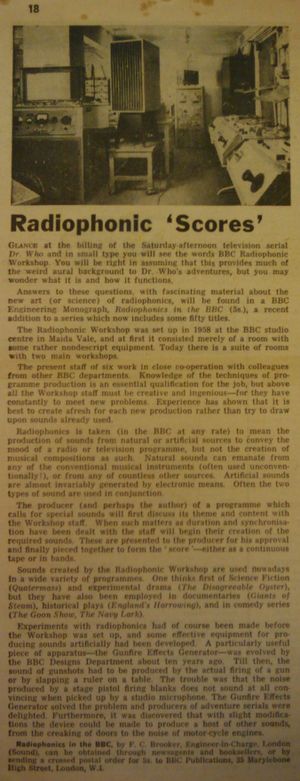Radiophonic `Scores'
There is a newspaper clipping in Delia's papers of a short article Radiophonic `Scores' about the Radiophonic Workshop and the publication of the 1963 monograph Radiophonics in the BBC.[1]
The reverse of the clipping, page 17, is headed February 16 SUNDAY, which dates the article to 1964.[2]
Transcript
Radiophonic ‘Scores’
Glance at the billing of the Saturday afternoon television serial Dr. Who and in small type you will see the words BBC Radiophonic Workshop. You will be right in assuming that this provides much of the weird aural background to Dr. Who's adventures, but you may wonder what it is and how it functions.
Answers to these questions with fascinating material about the new art (or science) of radiophonics, will be found in a BBC Engineering Monograph, Radiophonics in the BBC (5s.), a recent addition to a series which now includes some fifty titles.
The Radiophonic Workshop was set up in 1958 at the BBC studio centre in Maida Vale, and at first it consisted merely of a room with some rather nondescript equipment. Today there is a suite of rooms with two main workshops.
The present staff of six work in close co-operation with colleagues from other BBC departments. Knowledge of the techniques of programme production is an essential qualification for the job, but above all the Workshop staff must be creative and ingenious—for they have constantly to meet new problems. Experience has shown that it is best to create afresh for each new production rather than try to draw upon sounds already used.
Radiophonics is taken (in the BBC at any rate) to mean the production of sounds from natural or artificial sources to convey the mood of a radio or television programme, but not the creation of musical compositions as such. Natural sounds can emanate from any of the conventional musical instruments (often used unconventionally!), or from any of countless other sources. Artificial sounds are almost invariably generated by electronic means. Often the two types of sound are used in conjunction.
The producer (and perhaps the author) of a programme which calls for special sounds will first discuss its theme and content with the Workshop staff. When such matters as duration and synchronisation have been dealt with the staff will begin their creation of the required sounds. These are presented to the producer for his approval and finally pieced together to form the ‘score”—either as a continuous tape or in bands.
Sounds created by the Radiophonic Workshop are used nowadays in a wide variety of programmes. One thinks first of Science Fiction (Quatermass) and experimental drama (The Disagreeable Oyster), but they have also been employed in documentaries (Giants of Steam), historical plays (England's Harrowing), and in comedy series (The Goon Show, The Navy Lark).
Experiments with radiophonics had of course been made before the Workshop was set up, and some effective equipment for producing sounds artificially had been developed. A particularly useful piece of apparatus—the Gunfire Effects Generator—was evolved by the BBC Designs Department about ten years ago. Till then, the sound of gunshots had to be produced by the actual firing of a gun or by slapping a ruler on a table. The trouble was that the noise produced by a stage pistol firing blanks does not sound at all convincing when picked up by a studio microphone. The Gunfire Effects Generator solved the problem and producers of adventure serials were delighted. Furthermore, it was discovered that with slight modifications the device could be made to produce a host of other sounds, from the creaking of doors to the noise of motor-cycle engines.
Radiophonics in the BBC, by F. C. Brooker, Engineer-in-charge, London (Sound), can be obtained through newsagents and booksellers, or by sending a crossed postal order for 5s. to BBC Publications, 35 Marylebone High Street, London, W.1.
References
